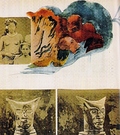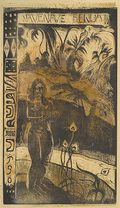In my last instalment of The Naked Beginner I told you how a fictional character prodded me to start exploring my artistic bent. Today I'll tell you about another... well... imaginary friend, for lack of a better term.
I'm the client of a great doctor here in Paris, a German allopath and homeopath whose nearly shamanic guidance has taken me to plenty of unexpected places over the years. When I last visited him he said, in his own words, “We are all two people, a day person and a night person, a doer and a dreamer, left brain and right brain, what you will. You can communicate with your night person directly and engage him or her. Sit up in bed last thing before going to sleep and say hello to him or her. Tell her you have a problem and you need her help. Outline the problem briefly. Then go to sleep, and let the night person solve the problem for you. You sleep all night, you wake up in the morning, and the problem is gone.”
Yeah, I know. Your day person is saying, “Nonsense." I thought the same thing at first, but I decided I’d have a go. (The German fellow has quite a track record with me.) I bought myself a spiral-bound notebook with blank pages. On the notebook's first page I glued a card with a photo of a children’s party where a bunch of 3- and 4-year-olds were screaming and playing with balloons. Inside the card I wrote, “My dear night person, I welcome you into my life. Please introduce yourself to me, tell me your name.” I added four stamps, from a trove of old stamps from all over the world I had bought at a philatelist’s just for this purpose.
That night I had a dream, and a young being, both male and female, came into my life. He, she was called Noï, written just like that. In German, “Neu” means “new” and it’s pronounced “NAW-ee.” In Italian, “Noi” means “We, us.” The name was beautiful, full of different meanings and connotations, musical, nice to say. Every night since that dream I have written to Noï, always starting my messages with “Dear Noï of the Beautiful Name.” I tell her a little about my day, I praise her infinite creativity, I thank her about all that she’s given me, and I ask her for more of everything.
I’ve presented Noï with problems, issues, desires, fears, goals, and tasks of all sorts—some creative, some professional, some affective. And Noï has helped me deal with a number of them. I won’t tell you what these tasks were precisely. (Hey, this is the Internet, after all! If I tell you my secrets they’ll be on every one’s tongues and ears in a nanosecond.) But I’ll tell you that Noï has helped me sleep much better, work more productively, and have steadier energy throughout the day. All for the price of a notebook and a ten-dollar bag of old stamps.
After I filled the notebook with my nightly postcards, I decided I’d change medium. Some years ago I saw a marvelous show of drawings by Alberto Giacometti, better known as a sculptor (in particular of extremely elongated figures). Several of his drawings were made with ballpoint pens, just like the cheap Bics you and I use to take notes and write checks and so on. The drawings were expressive and original. I couldn’t ever be or become Giacometti, I thought, but I could certainly handle a Bic. I bought a box of Bics of many colors—blue, black, red, and green—and, on a fresh notebook, I started drawing a different face every night, for Noï’s delectation.
I started off copying photos of friends and family, alternating the colors every night. My goddaughter Marianne in black, my mother in green, my grandmother in red. My efforts came out stilted and distorted. I myself could barely recognize my family members.
1303411-1147409-thumbnail.jpg
1303411-1147408-thumbnail.jpg
1303411-1147411-thumbnail.jpg
After a few nights maiming my elders, I chose to draw my nephew as a baby. Lo and behold, the portrait came out rather charming.
1303411-1147410-thumbnail.jpg
Er… it was kinda scary. I still thought of myself as a stick artist, and my accidental success challenged my aesthetics and my conception of myself. But deep down I was quite pleased. Every night I showed my drawings to my wife, who happens to be a trained artist,with a fine-arts college degree from Parsons. My wife indulges me, and I’m terribly grateful to her. “Cute,” she says. “Funny.” “Not so bad.” “Pretty good.” “The eyes are all screwy.” Actually, I resented that remark bitterly. But she was right. I couldn’t do eyes. Or lips. Or noses. Or cheekbones. Or—well, you get the idea.
The thing, though, was that I was finally drawing, for the first time in 35 years. My drawing hand (I’m a leftie) loved the feeling of the pen on paper. My visual perceptions were changing. I wasn’t afraid of making mistakes, and I was having tremendous fun.
Then Kimon Nicolaïdes entered my life. He was dead, of course. But I’m used to communing with fictional characters and ghosts inside my heart, so a dead man didn’t scare me one bit. Stay tuned for the next instalment of The Naked Beginner!



















